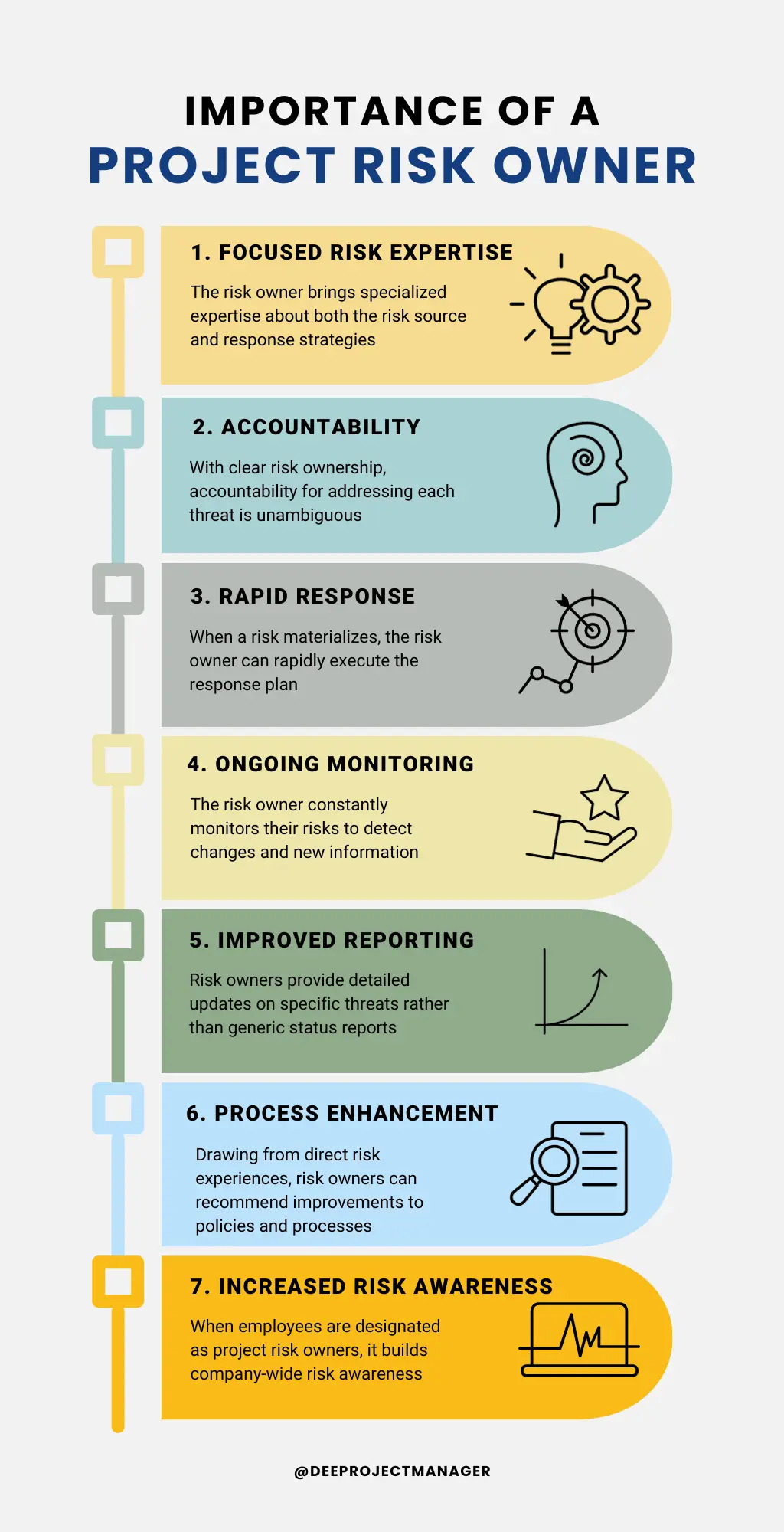As a project manager, you know that effectively managing risk is crucial to project success.
But who on your team should take ownership of identifying, assessing, and responding to those risks? Enter the risk owner.
Assigning a dedicated risk owner provides huge benefits for proactive risk management.
In this post, we’ll explore exactly what a project risk owner is, their key responsibilities, and how to select the right risk owner for your project.
Having the proper risk owner in place before issues arise is vital for monitoring threats and executing response plans.
Who is the Risk Owner in Project Management?
The project risk owner is the individual who is ultimately accountable for managing a specific risk throughout its lifecycle.
This person is responsible for ensuring the risk is properly identified, analyzed, and addressed through appropriate response strategies.
Typically, the risk owner is assigned during the risk identification process. As each risk emerges, the project manager will designate someone on the team with the appropriate skills, knowledge, and authority to “own” that risk.
Ideally, the risk owner is closely connected to the risk source and has expertise in that area. For example, the engineering lead may be assigned as risk owner for risks related to technical components.
The project risk owner acts as the point person for monitoring, tracking, and controlling their assigned risks. They also execute the risk response plan if a risk materializes.

Project Risk Owner Roles and Responsibilities
The project risk owner plays a pivotal role in identifying and addressing threats to project success.
Their specialized expertise helps drive effective risk management and they have several critical roles and responsibilities for managing risks throughout a project.
Some of their key duties include:
Identifying Risks
The risk owner plays an active part in the risk identification process by lending their expertise to spot potential threats and obstacles related to their assigned area.
Analyzing Risks
Once risks have been identified, the risk owner analyzes each one to determine its probability and potential impact on the project and then evaluates both quantitative and qualitative factors.
Developing Risk Responses
Drawing on their specialized knowledge, the risk owner develops appropriate risk response strategies.
This includes selecting risk avoidance, transference, mitigation, or acceptance actions, as well as creating risk response plans detailing how each risk will be addressed.
Implementing Risk Responses
When a risk response needs to be put into action, the risk owner executes the plan.
They lead the effort to avoid, transfer, mitigate, or accept the risk based on the chosen strategy.
Monitoring Risks
The risk owner continually monitors their assigned risks throughout the project, tracking them on the risk register, and watching for changes in probability or impact.
Reporting on Risks
The risk owner provides regular risk status updates to stakeholders and the project manager. They report on emerging threats, progress of responses, and any changes.
Recommending Risk Process Changes
Drawing on their hands-on experience, the risk owner recommends improvements to the risk management process based on lessons learned.

Importance of a Risk Owner in Project Management
Clearly defining risk authority and ownership is critical for controlling threats before they become major issues.
The focused expertise of a project risk owner enhances your overall risk management strategy.
Assigning a dedicated risk owner for each identified threat provides many advantages for proactive risk management including:
Focused Risk Expertise
The risk owner brings specialized expertise about both the risk source and response strategies. Their laser focus on assigned risks boosts analysis accuracy.
Accountability
With clear risk ownership, accountability for addressing each threat is unambiguous. The risk owner is solely responsible for managing their assigned risks.
Rapid Response
When a risk materializes, the risk owner can rapidly execute the response plan without confusion over who is in charge limiting the risk impact.
Ongoing Monitoring
The risk owner constantly monitors their risks to detect changes and new information allowing quicker response to developments.
Improved Reporting
Risk owners provide detailed updates on specific threats rather than generic status reports. This helps stakeholders understand exposure.
Risk Process Enhancements
Drawing from direct risk experiences, risk owners can recommend improvements to policies and processes to strengthen risk management.
Increased Risk Awareness
When employees are designated as project risk owners, it builds company-wide risk awareness and a risk-conscious culture.
Types of Risk Owners
There are a few different types of risk owners that may be assigned depending on the project context and nature of the threats.
The type of risk owner designated should align with the risk profile and scope.
- Primary Risk Owner: This refers to the individual who is assigned as the main risk owner for a particular risk. They have overall responsibility and authority for managing that risk.
- Shared Risk Owner: Some complex risks may have co-risk owners who share accountability. For example, a technical risk may have a primary engineering risk owner along with a secondary IT risk owner.
- Part-Time Risk Owner: This is a risk owner who is assigned temporarily to handle a specific risk activity like conducting additional analysis. They have limited defined duties.
- Hierarchical Risk Owner: On large projects, there may be risk owners assigned at various levels like subsidiary, departmental, divisional, and enterprise levels to distribute ownership.
- Committee Risk Owner: For organization-wide risks, a committee or working group may jointly handle risk ownership rather than a single individual.

Who Should be the Risk Owner in Project Management?
Choosing the right risk owner is crucial for effectively managing each identified threat. Consider these guidelines when selecting risk owners:
- Expertise and Experience: Look for individuals with specialized expertise related to the risk source. Their experience managing similar risks brings valuable insight.
- Available Capacity: Evaluate if the potential risk owner has enough bandwidth to take on monitoring and response duties. Be careful however to avoid overloading them.
- Authority Level: Risk owners should have sufficient authority to implement risk responses like allocating resources or changing processes.
- Communication Skills: Strong communicators who can clearly explain complex risks and response plans to stakeholders make ideal risk owners.
- Risk Management Skills: Consider candidates with training in risk management fundamentals who understand analysis models and tools.
- Problem-Solving Abilities: Choose self-starters who can work independently to develop and execute effective risk responses.
- Influence and Leadership: Risk owners may need to motivate teams to implement risk strategies, requiring political savvy and influence.
Project Risk Owner Examples
Here are a few examples of effective risk owners for common project threats:
- Technical Risks: For risks related to hardware, software, or systems, the engineering lead often serves as a risk owner. Their technical expertise allows thorough analysis and mitigation.
- Schedule Risks: The project manager is a natural fit as a risk owner for timeline threats like delays. They can adjust schedules and resources to get back on track.
- Budget Risks: The financial analyst or controller suits the risk owner role for budget overrun risks. They can find ways to reduce costs if needed.
- Resource Risks: Staffing shortages and attrition risks should be owned by the HR manager. They can lead the acquisition of supplemental resources.
- Quality Risks: For product defect or noncompliance risks, the QA lead may be ideal as a risk owner with a focus on process improvements.

Risk Owner vs Risk Manager
The risk owner and risk manager are roles that work closely together for effective risk management.
However, their roles differ in several key ways including:
- Responsibilities: The risk manager oversees the risk management process at the project level while the risk owner handles monitoring and responses for assigned risks.
- Scope: While the risk manager has a project-wide view, the risk owner focuses on specific threats.
- Accountability: Risk owners are directly accountable for their assigned risks. The risk manager on the other hand is responsible for the risk process overall.
- Authority: Risk owners decide and implement risk responses for their threats. The risk manager coordinates cross-project risk activities.
- Experience: The risk manager provides methodology guidance, while risk owners leverage specialized expertise.
- Reporting: Risk owners report to the risk manager on the status of assigned risks. The risk manager reports high-level risk info to stakeholders.

Risk Owner vs Control Owner
Control owners and risk owners are both roles that own processes in project management.
The distinctions between these roles include:
- Objective: The control owner implements and monitors processes to meet objectives. The risk owner on the other hand manages uncertainties that threaten project objectives.
- Focus: Control owners oversee the execution of standard procedures. Risk owners handle non-routine risks and responses.
- Expertise: Control owners bring process knowledge while risk owners have specialized risk and response skills.
- Approach: Control owners follow established control methods. Risk owners take flexible approaches tailored to each risk.
- Output: A control owner’s output is process compliance while a risk owner’s output is executed risk responses.
Difference Between a Risk Owner and a Risk Champion
While the risk owner and risk champion both promote risk management, their focuses differ:
- Role: The risk owner oversees a specific risk end-to-end. While the risk champion advocates the risk process broadly.
- Responsibilities: The risk owner manages the analysis, responses, and monitoring of assigned risks. The risk champion on the other hand coaches teams on risk practices.
- Focus: Risk owners concentrate on mitigating individual threats. Risk champions aim to build a strong risk culture.
- Authority: The risk owner has authority on responses for their risk. The risk champion influences through advice and mentoring.
- Experience: Risk owners have specialized expertise while risk champions have broad risk methodology knowledge.
- Tenure: Risk owners are designated for project duration. In contrast, risk champions are ongoing evangelists.
Final Thoughts
Designating a project risk owner helps organizations effectively manage threats that could impact objectives.
The risk owner oversees monitoring and responses for assigned risks using their specialized expertise.
Different types of risk owners can be matched to threats based on skills and experience.
Identifying the right risk owner for each risk is key to robust risk management and helps drive mitigation activities.
Project Risk Owner FAQs
During What Process Should a Project Manager Assign a Risk Owner?
According to the PMBOK Guide 6th Edition, risk owners for individual project risks may be nominated as part of the Identify Risks process, and will be confirmed during the Perform Qualitative Risk Analysis process.
Who Owns Risk in Agile?
In Agile methodology, risk is collectively owned by the entire team. However, the Scrum Master and Product Owner play key roles in facilitating risk identification, monitoring, and mitigation, fostering a collaborative approach to risk management.
Can Risk Owner and Control Owner be Same?
Yes, the risk owner and control owner can be the same person. They could be responsible for both identifying and managing a risk (risk owner), as well as implementing and maintaining the controls to mitigate that risk (control owner).
What is the Difference Between Risk Owner and Risk Approver?
The risk owner is responsible for managing and mitigating a specific risk, while the risk approver is typically a higher authority who validates and approves the risk response strategy proposed by the risk owner, ensuring it aligns with the organization’s risk appetite and policies.





